Michelia figo is the Botanical name for the Port Wine Magnolia. This is not a actually a plant closely related to the Magnolia trees, it's just a common name for this plant. This plant is an evergreen, ...it keeps it's leaves throughout the cooler months. Port Wine Magnolias are in bloom here in Sydney, and the flowers are deliciously fragrant, and are found in masses amongst the green leaves.. The flowers are not overly spectacular, but on a still windless night you really notice the perfume. The plant also makes a marvellous neat hedge or screen if trimmed regularly. In gardens , it is common to see a hedge maintained to a height of around 1 metre high or a little more. Without pruning, the plant will grow into a large shrub or small tree to about 3 to 4 metres.
Planted in a full sun position, the Port Wine Magnolia will flower well in Spring and early Summer. While not a really fast growing plant, give some regular water and fertilizer, it bushes up very nicely. It is suited for frost free cool-temperate, temperate and warmer climates.
I took these photos on a walk around Sydney's Northern Suburbs.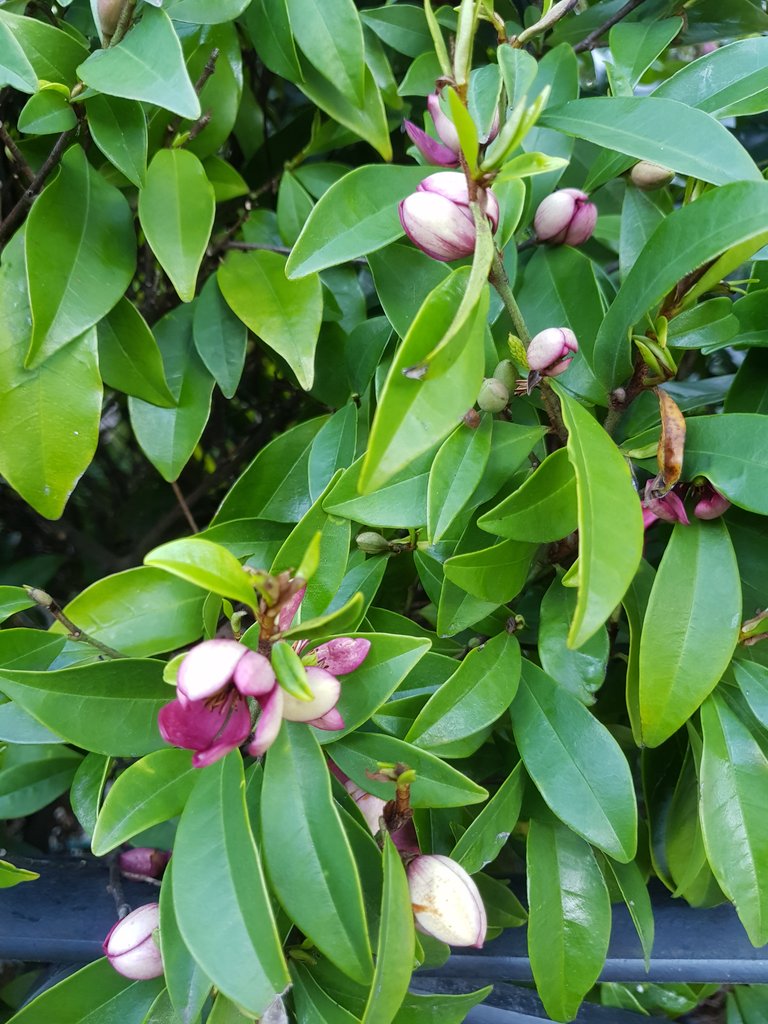
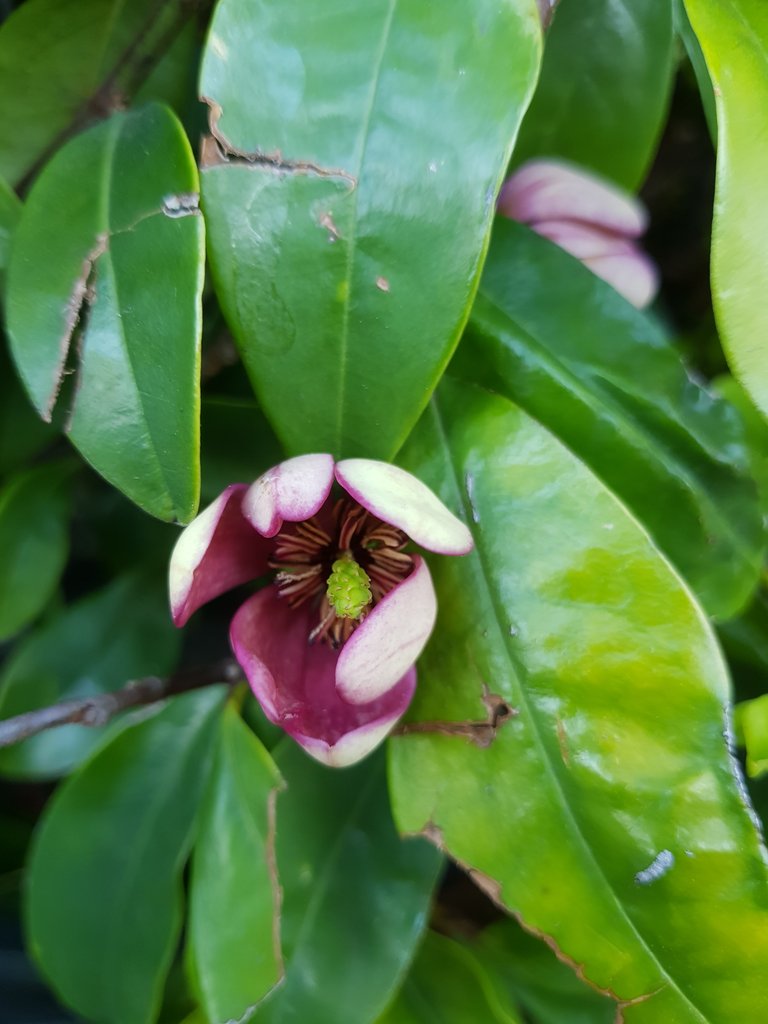
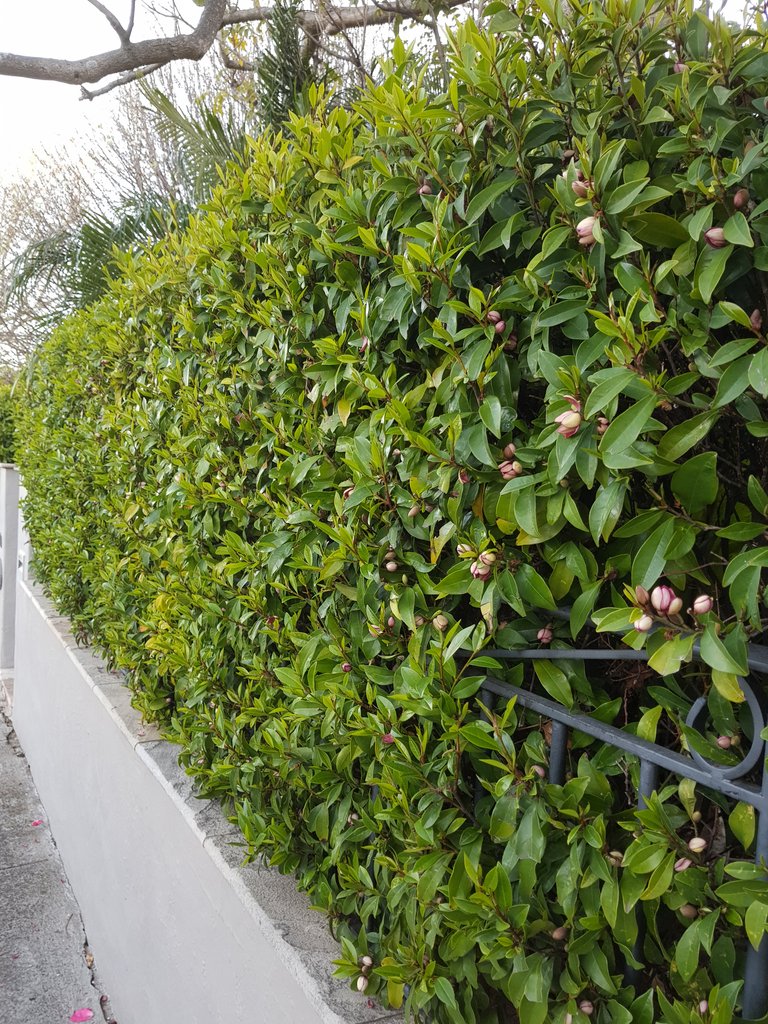
A popular fragrant shrub, Port Wine Magnolia is an evergreen flowering tree or shrub with perfumed flowers that are the colour of port wine.
Flowers will appear on old wood so it makes a good flowering and fragrant hedging plant, why is this ? Because even if you prune it it will flower… simple as that.
These are a slow growing plant, so advanced specimens will be costly. If you are looking for fantastic flowers, this is not the plant for you either, the flowers are small and fairly insignificant, but they smell great.
https://www.nurseriesonline.com.au/plant-index/trees-shrubs/magnolias/port-wine-magnolia/
Fav. comment Award !! Thanks for the great Pics.
Thank you very much sir.
Dense bushy shrub with dusky green glossy leaves. Cup shaped ivory tinged yellow flowers, with their base and margins tinged rose to purple. The flowers have an exquisite fragance, they appear in spring with a smaller autumn flush. It will grow in a wide range of sites but performs best in good soil in a semi-shade site. Fantastic for clipping into a low hedge or topairy shape. Good for planting near windows to enjoy the fragrance.
https://www.vibrantearth.nz/catalogue/plantsdetail.php?pid=957&name=
Fav. comment Award !! Great Pics, thanks.
Port Wine Magnolia produces small dark maroon purple cupped flowers in spring. Set amongst glossy green leaves, these beautifully scented flowers are not as showy as other Magnolias but have the most amazing bubble gum fragrance.
An evergreen dense shrub suitable for hedging or screening, Port Wine Magnolia flowers on old wood making it suitable for a clipped or formal hedge. Prefers a full sun to part shade position and is frost and drought tolerant once established. May be pruned after flowering to encourage new growth.
Source: https://www.gardenexpress.com.au/product/port-wine-magnolia/
I think I have seen very similar type plant in my country! Sometimes that might be the same plant! Unfortunately I am not good in this category, so it's hard to tell it's exactly the same one! But thickness of the leaves, I think they are more thicker than normal plant leaves! Nice photography and description as usual!@ctrl-alt-nwo,
Cheers~
I like Magnolia flowers.
Michelia figo is a plant that is able to immediately attract your eyes.
Excellent photos, @ctrl-alt-nwo
Listen to the song about magnolias from my youth, performed by VIA "Ariel".
Port Wine Magnolia is an attractive, evergreen shrub with glossy green leaves. It produces highly perfumed flowers in spring and summer that aren’t showy but smell fantastic, almost like bubblegum.
Growing to approximately three metres high, it will make a great hedge or individual specimen for any garden where the fragrance can be appreciated.
It will perform in full sun to part shade and prefers a moist, fertile soil. It needs summer water and mulch to keep the roots cool.
https://www.bunnings.com.au/330mm-port-wine-magnolia-michelia-figo_p3820340
Beautiful plant, my friend and a cousin of the lovely deciduous Magnolia genus, once classified as a Magnolia* itself and indeed known as the port wine magnolia, this evergreen shrub from China grows well in the Sydney climate and a good alternative to Magnolia in warmer areas where those plants don't do as well. Magnolia figo is a useful background specimen, with lushly green foliage and creamy, purple-flushed flowers in late spring/early summer. The tulip-shaped flowers are not showy like those of its more flamboyant Magnolia relatives, but they are strongly scented, with a fragrance described variously as resembling banana, port wine or bubblegum!
The rounded shrub grows 3-4 m tall, with a width of 1.5-3.5 m, but is said to be slow-growing. It can be pruned to shape after flowering to reduce its size. It will grow in sun or partial shade, and enjoys humus-rich, well-drained soil and sufficient water in summer. It doesn't like harsh frost. It can be used as a hedge or screen plant. Propagation is by semi-hardwood cuttings taken in summer and autumn.
There are several cultivars of the plant that have larger flowers and that apparently grow faster than the species, including 'Lady of the Night' (ht 4 m) and 'Coco' (ht 4 m). Michelia figo has also been hybridised with Michelia doltsopa (which is a rather large tree) to produce Michelia x foggii cultivars that are small trees with fragrant flowers in late winter or spring.
Thank you @ctrl-alt-nwo
http://www.igarden.com.au/plant-type.jsp?t=Michelia&q=Plant
Often I heard that Magnolia has a wonderful aroma. What I found on the Internet about this wonderful plant. Evergreen slow-growing shrub or small tree, no more than 3-5 meters high. The leaves are alternate, up to 12 cm long and up to 5 cm wide, obovate or elliptical, entire, with a wedge-shaped base, leathery, dark green, lighter on the underside, Young branches and brown buds. Large, solitary, axillary flowers (up to 4 cm in diameter), each have 6 creamy yellow or pale purple wax petals with an elegant dark red border around the edge. Flowers exude an intense aroma of banana. Mass flowering occurs in spring, but individual flowers appear on the plant during the entire warm period, and when grown in indoor conditions - year-round. Fragrant flowers are widely used in perfumery and cosmetology.
http://edenland.com.ua/semena/mikheliya-figo.html
Thanks for the interesting information.
Thanks again for sharing.
It's always a pleasure to share your content on twitter for my followers to see.
Shared on twitter promoting good quality content on #Steemit.
Have a great weekend.
Stephen
#Promo-Steem #steemtalent #JoinSteemit #Steemit
Port Wine Magnolia - get Drunk on the Perfume. #STEEM #steemtalent #JoinSteemit #Steemit @Steemit
#GardenersWorld #Gardening #Photographer #Photography #Blogger #Blog #Australia #Plants
Thanks Stephen !
Beautiful. The plant is very beautiful. Thank you, thanks to you, I first saw this beauty. Good luck and love to you.
Your post was mentioned in the Steemit Hit Parade in the following category:Congratulations @ctrl-alt-nwo!
Very interesting type of Magnolia with a variety of flowers and colours. I am not sure if this is what we have in our garden, but we call it another Thai name, the flowers are yellow just like the photos in your comment section. It is not bushy at all, more like a vine. Would love to get one for my garden to spread the perfume around.
If it's a vine, then that is not the same plant.
They do look beautiful by the way and added the fragrance I am sure they do smell cool too.
and I like it where the flowers were blooming and like how it is opening the flower, it is indeed a cool part.
Apart from all the images the last one looks nice
Nice magnolias you have there. I can imagine drunk kangaroos smelling them to get high. Or my Australia imagination is too wild? ;)
Makes a marvelous hedge with it's rich green leaves and pink flowers poking through all about.
Beautiful to look into that so nice and amazing it looks thanks for sharing about it in details
Magnolia figo (also called banana shrub, port wine magnolia, Michelia figo) is an evergreen tree growing to 3–4 metres (10–13 feet) tall. It is native to China.
It is cultivated as an ornamental plant in gardens for its fragrant flowers, which are cream-white, purple rounded, or light-purple, and strongly scented with isoamyl alcohol.
The leaves are leathery, dark glossy-green, up to 10 cm long. This plant is used in Shanghai, China, as a tall evergreen hedge. It grows to a large evergreen compact tree. It grows in acid and alkaline soil very well. Susceptible to black soot.
Source
Magnolia figo (also called banana shrub, port wine magnolia, Michelia figo) is an evergreen tree growing to 3–4 metres tall. It is native to China.

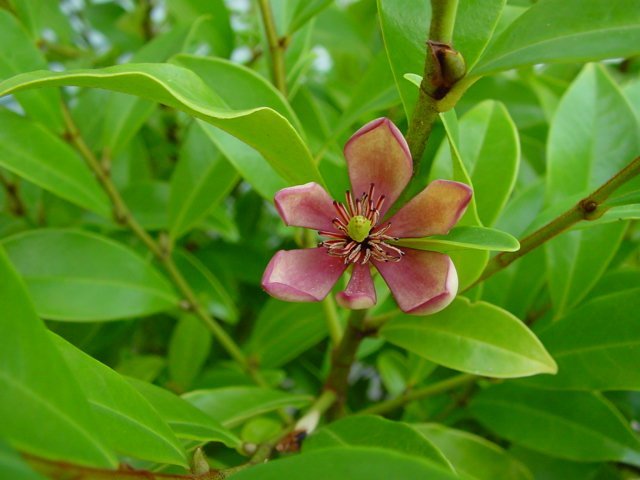.JPG)
Source
Initially described as by Portuguese missionary and naturalist João de Loureiro as Liriodendron figo, it was reclassified as Michelia figo by German botanist Curt Polycarp Joachim Sprengel. In 2006, a cladistic analysis of the genus Michelia found them to lie within the genus Magnolia, with the name now being Magnolia figo.
Source cultivated as an ornamental plant in gardens for its fragrant flowers, which are cream-white, purple rounded, or light-purple, and strongly scented with isoamyl alcohol. The leaves are leathery, dark glossy-green, up to 10 cm long. This plant is used in Shanghai, China, as a tall evergreen hedge. It grows to a large evergreen compact tree. It grows in acid and alkaline soil very well. Susceptible to black soot.
Source
i think this is the one really the same to the flower i show you bro!
Tibouchina , Lasiandra. Same plant. How big does it grow ?
it grows only 2-3 feet high..
oh yes,i just took a research about lasiandra it's really the same specially those leaves..but i love the colors of lasiandra flowers..it's cool for the eyes..
It could be a dwarf variety of Lasiandra.
yes, that was i thinking also cause Lasiandra i think it's 3-4 meters high!
Michelia figo



Description
The banana shrub is so called because of the distinctive, sweet banana scent of its flowers. These are formed within interesting fuzzy brown bracts that form a 1 in (2.5 cm) cigar-shaped bud. From these, small off-white flowers burst forth from late spring through summer. The blossoms are about 1.5 in (3.8 cm) in diameter with each of six waxy petals delicately outlined in dark red. Banana shrub is an evergreen woody plant with multiple stems and much branching. Left to itself it assumes a rounded open form reaching 15 ft (4.6 m) in height and almost as wide. The oblong, glossy green leaves are 3-5 in (7.6-12.7 cm) long by 1-2 in (2.5-5.1 cm) high.
Culture
Prefers acid, fertile, well drained soil with plenty of organic matter. Not particularly fast growing. May be pruned after blooming, but is most impressive when allowed to grow to natural size and shape. Although scale might develop, it is easily controlled. Nursery specimens of banana shrub tend to look scraggly, but containerized plants thrive once they are liberated from their pots.
Light: Sun to shade. The shrub assumes a looser more open form when grown in shade. Individuals grown in sunny situations tend to be more compact with denser foliage that is lighter and more yellow green.
Moisture: Average.
Hardiness: USDA Zones 8 - 10.
Propagation: From cuttings during warm weather.
Features
Banana shrub is a beautiful and interesting large plant that is especially useful in shade gardens where it can serve as a background and windshield for smaller woodland plants. The fragrant banana scented flowers are fascinating in form and fragrance. When grown as an understory plant under the canopy of taller trees the open branching structure provides excellent perches for songbirds in pursuit of prey.
References1234
Walk for sure at that time it's reflects as our life is slows down and, specially when we surround with greenery and colorful flowers then it will give the essence of pure Paradise.@ctrl-alt-nwo, When we go for an
And specially this plant hold the beautiful effect and what i really liked about these flowers is, these are purely reflecting as Pink Bells and also it reflecting as may be these flowers can whisper natural music.
Wishing you an great day and stay blessed. 🙂
Port Wine Magnolia is a plant that is widely planted as a hedgerow. Why? Because this plant is a beautiful bush. Therefore, this plant is also found in ornamental gardens because of its charm.
This flower is small. However, the aroma of the flower is quite amazing. This is also a practical reason why many people choose to plant this bush.
Port Wine Magnolias always look green and can grow to about 3m high. Purple-brown flowering and minimal visuals, but produce a very heavy, sweet aroma that is often described as similar to chewing gum or ripe bananas.
Port Wine Magnolia grows best in a frost-free zone and has dense leaf growth making them beautiful as a hedge plant.
Port Wine Magnolia prefers full sunlight, but can tolerate the shade. The soil must be well drained and enriched with organic materials such as compost or fertilizer.
In addition, pruning can be done after flowering (early summer) encourages new growth and development of new flower buds.
Source
Image from Pinterest!
Planting A Banana Shrub: How To Grow Banana Shrubs
Banana shrub is a tropical to subtropical elegant tree to bush. The scientific designation is Michelia figo, and the plant is hardy in the warmer USDA plant hardiness zones 7 to 10. Michelia banana shrubs are more properly trees that can grow 6 to 15 feet in height. If you are a warm region gardener, you should explore how to grow banana shrubs and experience the sweet fragrant flowers with a scent reminiscent of our favorite yellow fruits.
About Michelia Banana Shrubs Michelia banana shrubs are members of the Magnolia family, which is evident in the shape and form of their large blooms. The tree has glossy evergreen leaves and an attractive rounded habitat. The 3-inch long leaves are slightly fuzzy, and buds and new leaves are covered in rusty toned fuzz. But these aren’t its most spectacular attributes. Wait until late spring when the one inch cup-shaped cream rose or maroon colored flowers appear. Their scent is much like that of a ripe sweet banana.
How to Grow Banana Shrubs Choose a sunny location when planting a banana shrub, with well draining soil and adequate organic matter. Acidic soils create the best medium for planting a banana shrub.
Banana Shrub Care Michelia banana shrubs are low maintenance trees with no root invasiveness. Once established they are remarkably resistant to most pest and disease problems. Scale insects, however, are of particular concern and can cause severe defoliation but are easily managed with organic horticultural oil. Some root rot conditions may arise where the soil is too rich and moist. Young plants should be trained to one leader for the best overall effect on mature specimens. New banana shrub care should start with effective pruning of extra stems and suckers at the base of the plant. Choose the strongest, straightest trunk to provide a stable and attractive base for the plant.
Pruning Banana Shrubs The tree responds well to annual pruning. Pruning banana shrubs should be done when the plant is most dormant in winter or spring before new growth emerges. Always use sharp, clean cutting implements to prevent transferring diseases from plant to plant. Cut just after a bud node and remove any branch back to the branch collar where it sprung from the parent wood. Remove any dead or broken plant material and continue training young plants. Use a stake and tree sling when trees are forming, to help support the young growth. Remove these items when the plant is established and strong. Michelia banana shrubs tend to grow straighter in one central leader in lower light situations but in full sun they require more pruning maintenance. You can even keep the trees trimmed in a low habit so you can grow them in a container.
https://www.gardeningknowhow.com/ornamental/shrubs/banana-shrub/how-to-grow-banana-shrubs.htm
Evergreen dense shrub (3m x 3m) from China. Glossy green leaves. Perfumed yellow flowers edged with purple; almost hidden by foliage. Useful as a screen; hedge or specimen near paths for its perfume. Prefers moist well drained soil. Can be prone to scale attack. Frost tolerant. Drought sensitive.
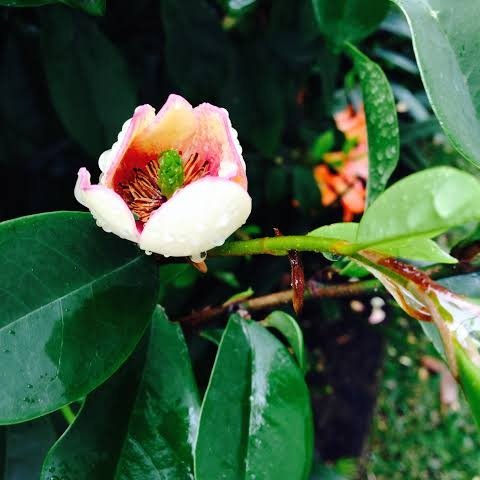
Source
It looks amazing , i never seen it in my country thanks for sharing
Really beautiful flowers you shared among us and thank you very much because these flowers are the first time I see. these flowers are not available in my country. I have seen so many beautiful flowers for you so thank you so much and your second picture is very nice. We are looking forward to seeing more beautiful flowers
Port Wine Magnolias (Michelia figo) are commonly grown in many gardens and are a very good choice as hedges or screen plants. However, they are a beautiful shrub and can therefore also be found on their own in ornamental gardens providing a central focal point - so don’t only think of them as a hedging plant.
Their flowers are quite small - you would not choose a Port Wine Magnolia for the visual impact of their flowers. However, the scent of their flowers is simply stunning and this is a reason why many people choose to grow this shrub. The scent is often described as being similar to a fruity chewing gum or bananas.
Plant Details
Common Names: Port Wine Magnolia, Banana Shrub, Banana Magnolia
Scientific Name: Michelia figo
Plant Description
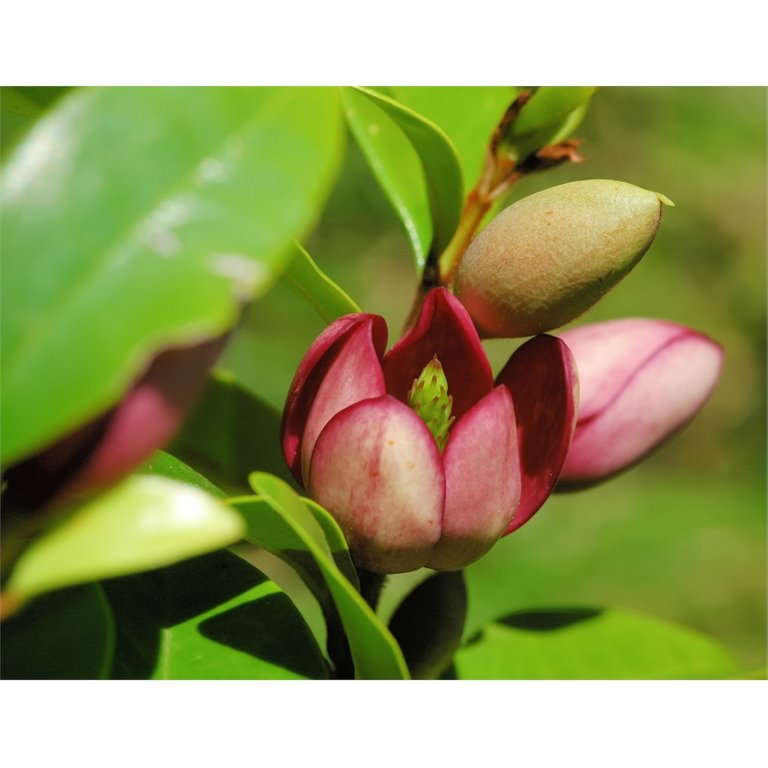 https://icultivate.net/articles/in-the-garden/entry/growing-port-wine-magnolias
https://icultivate.net/articles/in-the-garden/entry/growing-port-wine-magnolias
Port Wine Magnolias are evergreen and can grow to approximately 3m (10’) tall. They originate from Western China and produce small purple-brown flowers mid to late spring. These flowers are quite small and have minimal visual impact, but do produce and a very heavy, sweet scent that is often described as being similar to a fruity chewing gum or ripe bananas.
Flowers grow on old wood, therefore making them excellent for hedges as pruning that removes new growth does not remove new flower buds.
magoo-2 found a series of multi accounts of a same owner is following your articles to cheat your generous rewards.
magoo-2 found these accounts are suspicious & can be multi accounts of a single owner. Conclusion is based on last 30 days transactions:
@moniristi @shishiristi @aflatunnisa @hafez @shihabieee @mrashik
magoo-2
Check our latest multi comment spam update report
Michelia figo (Port Wine Magnolia) is an evergreen tree to 3 metres. It is an excellent choice for a flowering hedge. It has cream to purple coloured fleshy flowers with glossy dark green leaves, and a very string perfume that is reminiscent of bananas, tutti fruity gum or similar strong fruity smells.
Shallow rooted, but dense (but slow) growing, so perfect for hedges and topiary.
Grown in shade, Port Wine Magnolia shrubs grow more open and looser and as such may grow taller than expected. Port wines grown in sunny situations tend to be more compact with denser foliage.
It has an Evergreen lifecycle, which is defined as a plant that keeps its leaves throughout the year.
Normally growing to a mature height of 3.00 metres (9.75 feet), Port wine magnolia grows with a tree habit. This plant tends to bloom in early spring.
China is believed to be where Port wine magnolia originates from.
Port wine magnolia is normally fairly low maintenance and quite easy to grow, as long as a level of basic care is provided throughout the year. Being aware of the basic soil, sun and water preferences will result in a happier and healthier plant.
source
I have the parfume in my nose👌
Port Wine Magnolias (Michelia figo) are commonly grown in many gardens and are a very good choice as hedges or screen plants. However, they are a beautiful shrub and can therefore also be found on their own in ornamental gardens providing a central focal point - so don’t only think of them as a hedging plant.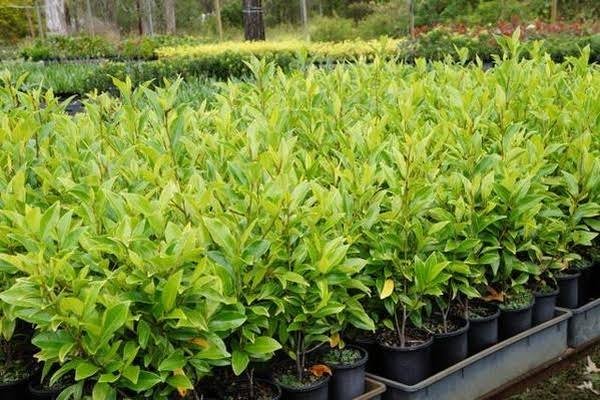.jpeg)
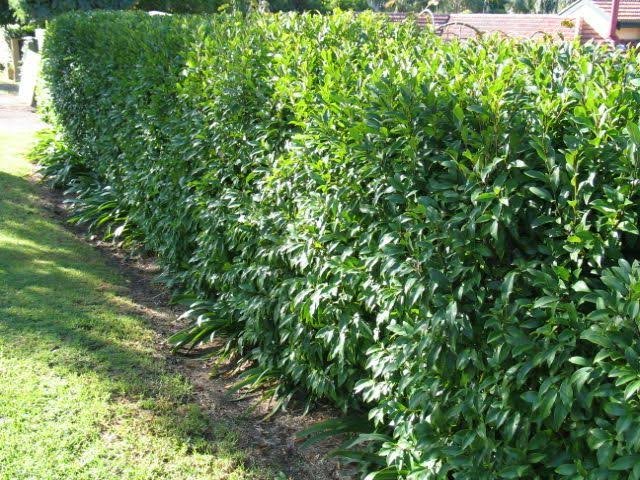.jpeg)

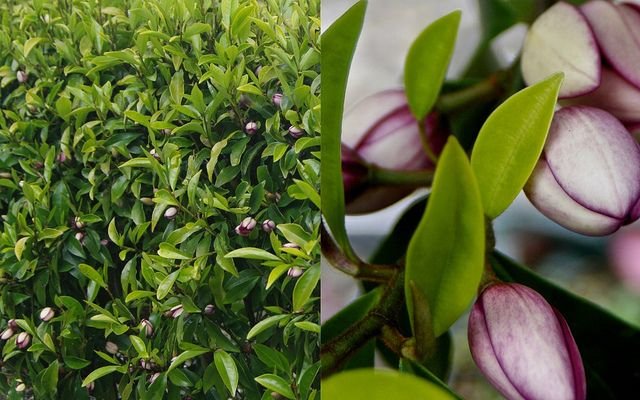 Soil should be well drained and enriched with organic matter such as compost and/or well aged manures.Pruning after flowering (early summer) promotes new growth and the development of new flower buds.
Soil should be well drained and enriched with organic matter such as compost and/or well aged manures.Pruning after flowering (early summer) promotes new growth and the development of new flower buds.
Their flowers are quite small - you would not choose a Port Wine Magnolia for the visual impact of their flowers. However, the scent of their flowers is simply stunning and this is a reason why many people choose to grow this shrub. The scent is often described as being similar to a fruity chewing gum or bananas.
Port Wine Magnolias are evergreen and can grow to approximately 3m (10’) tall. They originate from Western China and produce small purple-brown flowers mid to late spring. These flowers are quite small and have minimal visual impact, but do produce and a very heavy, sweet scent that is often described as being similar to a fruity chewing gum or ripe bananas.Flowers grow on old wood, therefore making them excellent for hedges as pruning that removes new growth does not remove new flower buds.
Port Wine Magnolias make wonderful hedges and screens. Their dense leaf growth enables them to be pruned to shape easily.They prefer full sun, but can tolerate part-shade.
[Source] https://www.google.com.pk/amp/s/icultivate.net/articles/in-the-garden/entry/growing-port-wine-magnolias%3fformat=amp
Unlike other members of the Magnolicae family, the Michelia Figo is an evergreen and offers glossy leaves all year around. With warm weather, anticipate the beautiful flowers that give it it’s name – A purple-red bloom with a strong heady fragrance.
For designs requiring more height, ‘White Caviar’, the hybrid cross of the popular Yunnanensis Magnolia and Michelia Figo, is a narrower option offering the same heady fragrance from a creamy white flower.
What truly makes the Michelia Figo stand out is it’s versatility for design. The figo makes for a beautiful compact stand alone shrub, can be potted and shaped, but we especially like it for the beautiful hedge it creates.
With it’s large, brilliant leaves, you can anticipate a hedge that adds vibrance to your landscape no matter what time of year. ‘White Caviar’ can also offer a more interesting screening option.
source
source
A popular fragrant shrub, Port Wine Magnolia is an evergreen flowering tree or shrub with perfumed flowers that are the colour of port wine.
Flowers will appear on old wood so it makes a good flowering and fragrant hedging plant, why is this ? Because even if you prune it it will flower… simple as that.
These are a slow growing plant, so advanced specimens will be costly. If you are looking for fantastic flowers, this is not the plant for you either, the flowers are small and fairly insignificant, but they smell great.
Really very useful as a feature plant near a pathway where the fragrance can be appreciated however they are also very suitable for a low hedge.
Over time a Port Wine Magnolia will reach a height of 3m but can easily be pruned back to shape and size, they can also be used as a specimen plant in a pot or container.
source
Port Wine Magnolia or Michelia figo is an attractive little shrub with mass of small flowers. The flowers themselves are insignificant compared to their unusual fruity scent. Some people compare the sweet scent to very ripe banana or port wine, but to me, it is more like a cocktail of many fruits mixed together. I imagine the smell is like the mixture of banana, apple, pear, pineapple, passionfruit, mango, kiwi fruit and water melon :o)
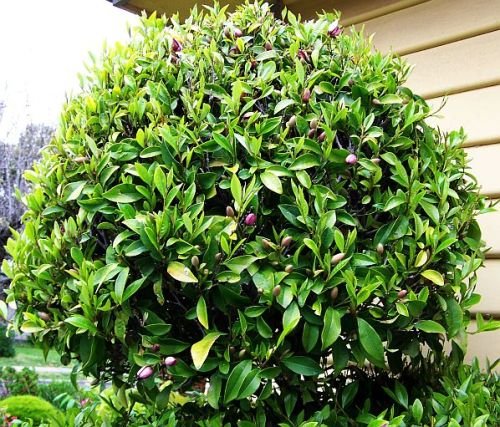
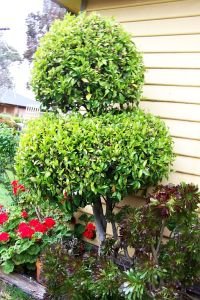
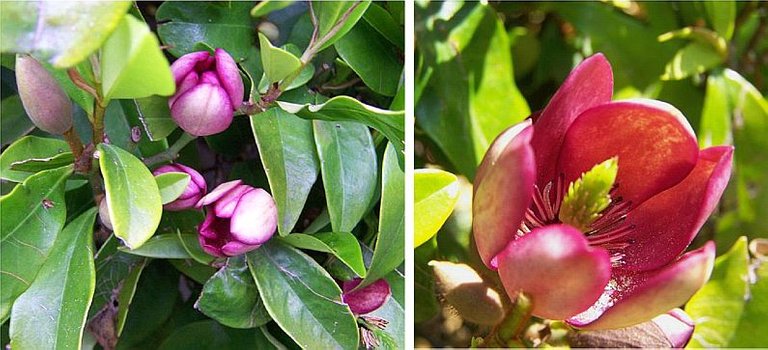 https://kiyanti2008.wordpress.com/2010/10/04/port-wine-magnolia/
https://kiyanti2008.wordpress.com/2010/10/04/port-wine-magnolia/
When the sun is shining bright and the weather is warm, the fruity fragrance lingers and it gets really strong if you have a sniff at the shy little flowers. I say shy because many of them are hidden behind the green glossy leaves:o) and once open they are very fragile. They fall apart at the slightest touch.
We planted our port-wine magnolia long time ago (don’t remember when) and it seems that it has no problems and it survives the extreme heat of Melbourne summer. We have shaped ours into an informal 2 tiered topiary and regular trimmings make the plant grow compact and neat. Once established, it will be happy to be left alone. I hardly water it (only when the summer is very dry) but I apply slow released fertiliser once a year. I also use some mulch to keep the soil cool and moist.
Michelia figo – Evergreen, rounded shrub or small tree with oval, glossy, rich green leaves. Strongly scented creamy yellow flowers edged purple with fleshy petals in Spring and Summer. Height and Spread up to 3mtrs.
Care: Michelias like a position in full sun or part shade, and a well-drained soil enriched with compost or well-rotted cow manure. Prune after flowering to encourage new flowering growth.
source
Port Wine Magnolia
Michelia is an evergreen tree in the Magnolia family - and has, in fact, been re-classified as a magnolia. Michelia have smaller leaves than Magnolia grandiflora, and more flowers, as flower-buds form in each leaf-axel, not just at the tips.
Some cultivars re-bloom in Summer.. Michelia - or magnolia- figo is an evergreen tree growing to 3-4 m tall. It is cultivated as an ornamental plant in gardens for its fragrant flowers, which are cream-white, purple rounded, or light-purple.
source
The Port Wine Magnolia (Michelia figo) or Banana Shrub, is an evergreen shrub that has small & glossy, bright green leaves. During spring and summer it produces purple and red flowers which are quite fragrant emitting a fruity scent similar to that of bananas or vintage port.
It grows into a large evergreen compact tree. In a container however it will rarely exceed 2 meters in height.
If you live outside of Sydney, please enquire first before purchasing this plant. We only supply smaller plants (15cm pot size or smaller) outside of Sydney, but if the quantity purchase is large enough we can price you on the freight. Thank you for your understanding.
Position: Full sun to part shade
Height: 3m to 4m
Width: 3m to 4m
Type: Feature
source
Words used to describe this close cousin of the Magnolia are "best ever flowering tree", "lots of bang behind the bloom" "top performer, under-rated".
Some members of the Michelia family such as Michelia figo (Port Wine Magnolia) are a little shy showing off their assets and therefore can be overlooked by the gardener.

This would be a mistake. The flowers may be a little hidden by the foliage but when you go out into the garden in early evening the delightful fragrance will definitely lead you by the nose.
Michelias offer glossy evergreen foliage that doesn';t mind being cliped into whatever shape you like, quantity of blooms to rival many garden plants, intense fragrance and a neat and tidy habit. Michelias can be used for topiary and hedging and they grow very hapily in a container.
source
Wow so very beautiful garden, thanks for sharing.really nice forWine Magnolia flowers.....
Resteem
Flowers are small . But dark green leaves are also looking beautiful . Good source of oxizen. Very useful plant for hot climate . Thanks
Le message de la fleur de magnolia est…
On pense que l’arbre de magnolia fut l’une des premières plantes à fleurs à évoluer sur Terre. Selon l’association « San Francisco Botanical Garden Society », des restes fossiles montrent que les magnolias vivaient sur terre il y a 100 millions d’années. En gros, tous les magnolias ont eu la même évolution. Les magnolias anciens sont encore reconnaissables aujourd’hui en tant que magnolias. De toute évidence, les magnolias ont trouvé un excellent moyen de survivre. Qui sait ? Peut-être qu’ils survivront bien longtemps après la disparition de l’être humain ! Nous pouvons donc dire que la fleur de magnolia, en perpétuelle évolution, est synonyme de longévité et de grâce.
sorse:
vidio:
The multi-petalled white, heavily scented flowers open about this time here. Native to West Yunnan, Tibet and the West Himalayas, it was introduced into western gardens in 1918, and given the prestigious Award of Merit by the Royal Horticultural Society in 1961, a guarantee of an outstanding plant.
TWO unfamiliar varieties have been bred by Bob Cherry, of Paradise Plants, at Kulnura, north of Gosford. Cherry, famous for his breeding of Camellia sasanquas, has been on plant-hunting expeditions to China and other regions in the Himalayas dozens of times looking for rare plants he can develop and bring to the public.
Michelia yunnanensis or “Paradise Perfection” as Cherry says “embodies the timeless mystery and peaceful contemplation of the temple slopes of China”.
This is a relatively new form with all the elegance and perfume of the common Michelia with the added bonus of more flowers and compact dense foliage.
source
Each year in late winter, deciduous magnolia opens up impressive blooms on foliage-free stems before the bright green leaves arrive in spring.
The large, fragrant flowers come in white, pink, purple or yellow, and can be on display for weeks at a time, cheering up a garden otherwise devoid of colour.
An ancient plant family that originated in China, Magnoliaceae has more than 80 species in the genus, and fossil records show some are almost 60 million years old.
Magnolias have been highly prized throughout history.
Intrepid plant hunters from Britain braved dangerous journeys in the 18th century to search for the exotic plant in China, the Himalayas and Tibet.
source